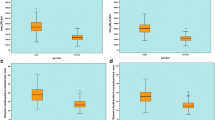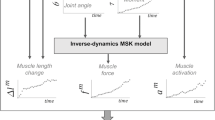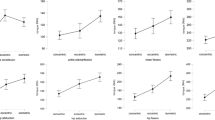Abstract
Because the force-generating capacities of muscles are currently estimated using anatomical data obtained from cadaver specimens, hand musculoskeletal models provide only a limited representation of the specific features of individual subjects. A scaling method is proposed to individualise muscle capacities using dynamometric measurements and electromyography. For each subject, a strength profile was first defined by measuring net moments during eight maximum isometric contractions about the wrist and metacarpophalangeal joints. The capacities of the five muscle groups were then determined by adjusting several parameters of an initial musculoskeletal model using an optimisation procedure which minimised the differences between measured moments and model estimates. Sixteen volunteers, including three particular participants (one climber, one boxer and one arthritic patient), were recruited. Compared with the initial literature-based model, the estimated subject-specific capacities were on average five times higher for the wrist muscles and twice as high for the finger muscles. The adjustments for particular subjects were consistent with their expected specific characteristics, e.g. high finger flexor capacities for the climber. Using the subject-specific capacities, the model estimates were markedly modified. The proposed protocol and scaling procedure can capture the specific characteristics of the participants and improved the representation of their capacities in the musculoskeletal model.





Similar content being viewed by others
References
Dennerlein JT, Diao E, Mote CD, Rempel DM (1998) Tensions of the flexor digitorum superficialis are higher than a current model predicts. J Biomech 31:295–301
Erdemir A, McLean S, Herzog W, van den Bogert AJ (2007) Model-based estimation of muscle forces exerted during movements. Clin Biomech 22:131–154. doi:10.1016/j.clinbiomech.2006.09.005
Brand PW, Beach RB, Thompson DE (1981) Relative tension and potential excursion of muscles in the forearm and hand. J Hand Surg 6:209–219. doi:10.1016/S0363-5023(81)80072-X
Buchanan TS (1995) Evidence that maximum muscle stress is not a constant: differences in specific tension in elbow flexors and extensors. Med Eng Phys 17:529–536. doi:10.1016/1350-4533(95)00005-8
Close RI (1972) Dynamic properties of mammalian skeletal muscles. Physiol rev 52:129–197
Zajac FE (1989) Muscle and tendon: properties, models, scaling, and application to biomechanics and motor control. Crit Rev Biomed Eng 17:359–411
Powell PL, Roy RR, Kanim P et al (1984) Predictability of skeletal muscle tension from architectural determinations in guinea pig hindlimbs. J Appl Physiol 57:1715–1721
Crowninshield RD, Brand RA (1981) A physiologically based criterion of muscle force prediction in locomotion. J Biomech 14:793–801. doi:10.1016/0021-9290(81)90035-X
Rasmussen J, Damsgaard M, Voigt M (2001) Muscle recruitment by the min/max criterion—a comparative numerical study. J Biomech 34:409–415. doi:10.1016/S0021-9290(00)00191-3
Cooney W, Chao E (1977) Biomechanical analysis of static forces in the thumb during hand function. J Bone Joint Surg Am 59:27–36
Brook N, Mizrahi J, Shoham M, Dayan J (1995) A biomechanical model of index finger dynamics. Med Eng Phys 17:54–63. doi:10.1016/1350-4533(95)90378-O
Valero-Cuevas FJ, Zajac FE, Burgar CG (1998) Large index-fingertip forces are produced by subject-independent patterns of muscle excitation. J Biomech 31:693–703. doi:10.1016/S0021-9290(98)00082-7
Vigouroux L, Quaine F, Labarre-Vila A et al (2007) Using EMG data to constrain optimization procedure improves finger tendon tension estimations during static fingertip force production. J Biomech 40:2846–2856. doi:10.1016/j.Jbiomech.2007.03.010
Sancho-Bru JL, Pérez-González A, Vergara-Monedero M, Giurintano D (2001) A 3-D dynamic model of human finger for studying free movements. J Biomech 34:1491–1500. doi:10.1016/S0021-9290(01)00106-3
Fok KS, Chou SM (2010) Development of a finger biomechanical model and its considerations. J Biomech 43:701–713. doi:10.1016/j.jbiomech.2009.10.020
Vigouroux L, Domalain M, Berton E (2009) Comparison of tendon tensions estimated from two biomechanical models of the thumb. J Biomech 42:1772–1777. doi:10.1016/j.jbiomech.2009.03.052
Sancho-Bru JL, Perez-Gonzalez A, Vergara M, Giurintano DJ (2003) A 3D biomechanical model of the hand for power grip. J Biomech Eng 125:78–83. doi:10.1115/1.1532791
Vigouroux L, Domalain M, Berton E (2011) Effect of object width on muscle and joint forces during thumb-index finger grasping. J Appl Biomech 27:173–180
Goislard de Monsabert B, Rossi J, Berton E, Vigouroux L (2012) Quantification of hand and forearm muscle forces during a maximal power grip task. Med Sci Sports Exerc 44:1906–1916. doi:10.1249/MSS.0b013e31825d9612
Sancho-Bru JL, Vergara M, Rodríguez-Cervantes P-J et al (2008) Scalability of the muscular action in a parametric 3D model of the index finger. Ann Biomed Eng 36:102–107. doi:10.1007/s10439-007-9395-6
Holzbaur KRS, Murray WM, Delp SL (2005) A model of the upper extremity for simulating musculoskeletal surgery and analyzing neuromuscular control. Ann Biomed Eng 33:829–840. doi:10.1007/s10439-005-3320-7
O’Brien TD, Reeves ND, Baltzopoulos V et al (2010) In vivo measurements of muscle specific tension in adults and children. Exp Physiol 95:202–210. doi:10.1113/expphysiol.2009.048967
Maganaris CN, Baltzopoulos V, Ball D, Sargeant AJ (2001) In vivo specific tension of human skeletal muscle. J Appl Physiol 90:865–872
Erskine RM, Jones DA, Maganaris CN, Degens H (2009) In vivo specific tension of the human quadriceps femoris muscle. Eur J Appl Physiol 106:827–838. doi:10.1007/s00421-009-1085-7
An KN, Ueba Y, Chao EY et al (1983) Tendon excursion and moment arm of index finger muscles. J Biomech 16:419–425. doi:10.1016/0021-9290(83)90074-X
Lemay MA, Crago PE (1996) A dynamic model for simulating movements of the elbow, forearm, and wrist. J Biomech 29:1319–1330. doi:10.1016/0021-9290(96)00026-7
An KN, Chao EY, Cooney WP III, Linscheid RL (1979) Normative model of human hand for biomechanical analysis. J Biomech 12:775–788. doi:10.1016/0021-9290(79)90163-5
Kawakami Y, Abe T, Kuno S-Y, Fukunaga T (1995) Training-induced changes in muscle architecture and specific tension. Eur J Appl Physiol 72:37–43. doi:10.1007/BF00964112
Narici MV, Maganaris CN, Reeves ND, Capodaglio P (2003) Effect of aging on human muscle architecture. J Appl Physiol 95:2229–2234. doi:10.1152/japplphysiol.00433.2003
Rasch A, Byström AH, Dalen N, Berg HE (2007) Reduced muscle radiological density, cross-sectional area, and strength of major hip and knee muscles in 22 patients with hip osteoarthritis. Acta Orthop 78:505–510. doi:10.1080/17453670710014158
Blemker SS, Asakawa DS, Gold GE, Delp SL (2007) Image-based musculoskeletal modeling: applications, advances, and future opportunities. J Magn Reson Imaging JMRI 25:441–451. doi:10.1002/jmri.20805
Hausselle J, Assi A, El Helou A et al (2014) Subject-specific musculoskeletal model of the lower limb in a lying and standing position. Comput Methods Biomech Biomed Engin 17:480–487. doi:10.1080/10255842.2012.693173
Scheys L, Desloovere K, Suetens P, Jonkers I (2011) Level of subject-specific detail in musculoskeletal models affects hip moment arm length calculation during gait in pediatric subjects with increased femoral anteversion. J Biomech 44:1346–1353. doi:10.1016/j.jbiomech.2011.01.001
Hatze H (1981) Estimation of myodynamic parameter values from observations on isometrically contracting muscle groups. Eur J Appl Physiol 46:325–338. doi:10.1007/BF00422120
Gonzalez RV, Buchanan TS, Delp SL (1997) How muscle architecture and moment arms affect wrist flexion-extension moments. J Biomech 30:705–712
Hale R, Dorman D, Gonzalez RV (2011) Individual muscle force parameters and fiber operating ranges for elbow flexion-extension and forearm pronation-supination. J Biomech 44:650–656. doi:10.1016/j.jbiomech.2010.11.009
Garner BA, Pandy MG (2003) Estimation of musculotendon properties in the human upper limb. Ann Biomed Eng 31:207–220. doi:10.1114/1.1540105
Nussbaum MA, Chaffin DB (1998) Lumbar muscle force estimation using a subject-invariant 5-parameter EMG-based model. J Biomech 31:667–672. doi:10.1016/S0021-9290(98)00055-4
Amarantini D, Martin L (2004) A method to combine numerical optimization and EMG data for the estimation of joint moments under dynamic conditions. J Biomech 37:1393–1404. Doi: 16/j.Jbiomech.2003.12.020
Infantolino BW, Challis JH (2014) Measuring subject specific muscle model parameters of the first dorsal interosseous in vivo. Ann Biomed Eng 42:1331–1339. doi:10.1007/s10439-014-1002-z
Olney SJ, Winter DA (1985) Predictions of knee and ankle moments of force in walking from EMG and kinematic data. J Biomech 18:9–20
Schweizer A, Frank O, Ochsner PE, Jacob HAC (2003) Friction between human finger flexor tendons and pulleys at high loads. J Biomech 36:63–71. doi:10.1016/S0021-9290(02)00242-7
Chao EY, An KN, Cooney WP III, Linscheid RL (1989) Biomechanics of the hand: a basic research study. World Scientific
Goislard de Monsabert B, Vigouroux L, Bendahan D, Berton E (2014) Quantification of finger joint loadings using musculoskeletal modelling clarifies mechanical risk factors of hand osteoarthritis. Med Eng Phys 36:177–184. doi:10.1016/j.medengphy.2013.10.007
Ramsay JW, Hunter BV, Gonzalez RV (2009) Muscle moment arm and normalized moment contributions as reference data for musculoskeletal elbow and wrist joint models. J Biomech 42:463–473. doi:10.1016/j.jbiomech.2008.11.035
Buchholz B, Armstrong TJ, Goldstein SA (1992) Anthropometric data for describing the kinematics of the human hand. Ergonomics 35:261–273
Delp SL, Grierson AE, Buchanan TS (1996) Maximum isometric moments generated by the wrist muscles in flexion-extension and radial-ulnar deviation. J Biomech 29:1371–1375. doi:10.1016/0021-9290(96)00029-2
Holzbaur KRS, Delp SL, Gold GE, Murray WM (2007) Moment-generating capacity of upper limb muscles in healthy adults. J Biomech 40:2442–2449. doi:10.1016/j.jbiomech.2006.11.013
Vigouroux L, Goislard de Monsabert B, Berton E (2014) Estimation of hand and wrist muscle capacities in rock climbers. Eur J Appl Physiol. doi:10.1007/s00421-014-3076-6
Vigouroux L, de Monsabert, BG , Hayot C, et al (2016) Assessment of the risk and biomechanical consequences of lateral epicondylalgia by estimating wrist and finger muscle capacities in tennis players. Sports Biomech 0:1–18. doi: 10.1080/14763141.2016.1212916
Acknowledgments
All the authors acknowledge that there is no conflict of interest that could inappropriately influence their work. We would like to thank Dr. Jérémy Rossi for his help in designing the ergometer used in this study.
Author information
Authors and Affiliations
Corresponding author
Ethics declarations
Funding
This study did not involve any external source of funding.
Conflict of interest
The authors declare that they have no conflict of interest.
Ethics approval and consent to participate
Each participant gave their informed consent, and the protocol was approved by the local ethics committee.
Rights and permissions
About this article
Cite this article
Goislard de Monsabert, B., Rao, G., Gay, A. et al. A scaling method to individualise muscle force capacities in musculoskeletal models of the hand and wrist using isometric strength measurements. Med Biol Eng Comput 55, 2227–2244 (2017). https://doi.org/10.1007/s11517-017-1662-6
Received:
Accepted:
Published:
Issue Date:
DOI: https://doi.org/10.1007/s11517-017-1662-6




